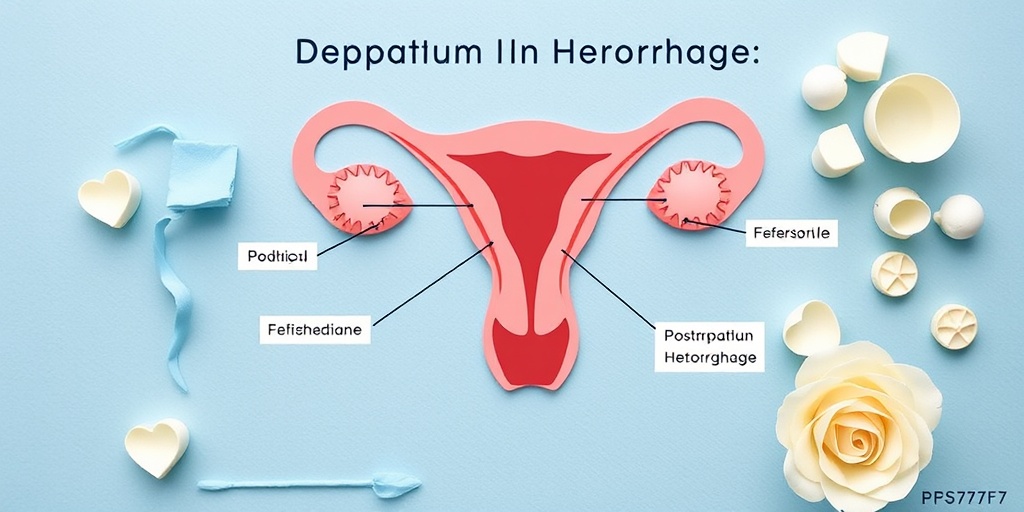Understanding Postpartum Hemorrhage
Postpartum hemorrhage (PPH) is a serious condition that can occur after childbirth, characterized by excessive bleeding. It is crucial for new mothers and their families to understand PPH, its causes, symptoms, and management to ensure a safe postpartum experience. In this article, we will delve into what PPH is, its risk factors, and how it can be effectively managed.
What Is PPH?
PPH is defined as blood loss greater than 500 milliliters (ml) following a vaginal delivery or more than 1000 ml after a cesarean section. It can occur immediately after delivery or within the first 24 hours, known as primary PPH, or later, termed secondary PPH. Understanding the distinction between these two types is vital for timely intervention.
Causes of Postpartum Hemorrhage
Several factors can contribute to the occurrence of PPH, including:
- Uterine Atony: This is the most common cause of PPH, where the uterus fails to contract effectively after delivery, leading to excessive bleeding.
- Tears or Lacerations: Injuries to the cervix, vagina, or perineum during childbirth can result in significant blood loss.
- Retained Placenta: If parts of the placenta remain in the uterus after delivery, it can prevent the uterus from contracting properly.
- Coagulation Disorders: Some women may have underlying conditions that affect blood clotting, increasing the risk of PPH.
Symptoms of PPH
Recognizing the symptoms of PPH is crucial for prompt treatment. Common signs include:
- Heavy vaginal bleeding (soaking through one or more pads in an hour)
- Severe abdominal pain or cramping
- Lightheadedness or fainting
- Rapid heartbeat
- Pale or clammy skin
If you or someone you know experiences these symptoms after childbirth, it is essential to seek medical attention immediately. Early intervention can be life-saving.
Risk Factors for PPH
While PPH can affect any woman, certain risk factors may increase the likelihood of experiencing this condition:
- Previous History: Women who have had PPH in previous pregnancies are at a higher risk.
- Multiple Pregnancies: Carrying twins or more can increase the risk of uterine atony.
- Prolonged Labor: Extended labor can lead to fatigue of the uterine muscles.
- Obesity: Higher body mass index (BMI) can be associated with complications during delivery.
Management and Treatment of PPH
Effective management of PPH is critical to ensure the safety of the mother. Treatment options may include:
- Medications: Uterotonics, such as oxytocin, can help stimulate uterine contractions and reduce bleeding.
- Surgical Interventions: In severe cases, surgical procedures may be necessary to control the bleeding.
- Blood Transfusions: If blood loss is significant, transfusions may be required to restore blood volume.
Healthcare providers are trained to recognize and respond to PPH quickly, ensuring that mothers receive the care they need. It is also beneficial for new mothers to discuss their birth plans and any concerns regarding PPH with their healthcare team before delivery.
Conclusion
Understanding postpartum hemorrhage is essential for new mothers and their families. By being aware of the causes, symptoms, and management strategies, you can help ensure a safer postpartum experience. If you have any questions or concerns about PPH, consider visiting Yesil Health AI for evidence-based health answers and support. Remember, knowledge is power, and being informed can make all the difference in your health journey! 🌼

PPH Symptoms
Postpartum hemorrhage (PPH) is a serious condition that can occur after childbirth, characterized by excessive bleeding. Recognizing the symptoms early is crucial for effective management and treatment. Here are the primary symptoms to watch for:
1. Excessive Bleeding
The most obvious symptom of PPH is excessive vaginal bleeding. While some bleeding is normal after delivery, PPH is typically defined as losing more than 500 milliliters of blood following a vaginal birth or more than 1,000 milliliters after a cesarean section. If you notice that your bleeding is soaking through one or more pads in an hour, it’s essential to seek medical attention immediately.
2. Blood Clots
Large blood clots can also be a sign of PPH. While small clots may be normal, clots larger than a golf ball can indicate a problem. If you experience this, it’s important to consult with your healthcare provider.
3. Dizziness or Fainting
Feeling dizzy, lightheaded, or faint can be a result of significant blood loss. This symptom may indicate that your body is struggling to cope with the decreased blood volume. If you experience these feelings, especially when standing up, it’s crucial to get help right away.
4. Rapid Heart Rate
A rapid heart rate (tachycardia) can be another indicator of PPH. As your body loses blood, your heart works harder to maintain blood flow, leading to an increased heart rate. If you notice your heart racing, especially in conjunction with other symptoms, don’t hesitate to reach out for medical assistance.
5. Weakness or Fatigue
Feeling unusually weak or fatigued can also be a symptom of PPH. This may be due to the body’s response to blood loss. If you find it difficult to stay awake or feel excessively tired, it’s important to inform your healthcare provider.
PPH Causes
Understanding the causes of postpartum hemorrhage (PPH) can help in prevention and early detection. PPH can occur due to various factors, and knowing these can empower new mothers and their families. Here are some common causes:
1. Uterine Atony
The most common cause of PPH is uterine atony, which occurs when the uterus fails to contract effectively after delivery. This lack of contraction can lead to excessive bleeding. Factors that may contribute to uterine atony include:
- Prolonged labor
- Overdistension of the uterus (e.g., multiple pregnancies)
- Use of certain medications during labor
2. Retained Placenta
Another significant cause of PPH is the retention of placental tissue in the uterus after delivery. If parts of the placenta remain, they can prevent the uterus from contracting properly, leading to continued bleeding. This can occur if the placenta does not detach completely during childbirth.
3. Trauma During Delivery
Injuries to the birth canal, such as tears or lacerations, can also result in PPH. These injuries may occur during a difficult delivery or if instruments are used. It’s essential for healthcare providers to assess for any trauma to ensure proper treatment.
4. Coagulation Disorders
Some women may have underlying coagulation disorders that affect their blood’s ability to clot. Conditions such as von Willebrand disease or thrombocytopenia can increase the risk of PPH. If you have a history of bleeding disorders, it’s vital to discuss this with your healthcare provider before delivery.
5. Placenta Previa or Placental Abruption
Conditions like placenta previa (where the placenta covers the cervix) or placental abruption (where the placenta detaches from the uterus prematurely) can also lead to PPH. These conditions can cause significant bleeding during pregnancy and delivery, necessitating careful monitoring and management.
Recognizing the symptoms and understanding the causes of PPH can significantly impact outcomes for new mothers. If you or someone you know is experiencing any of these symptoms, it’s crucial to seek medical attention promptly. 🩺

PPH Risk Factors
Postpartum hemorrhage (PPH) is a serious condition that can occur after childbirth, characterized by excessive bleeding. Understanding the risk factors associated with PPH is crucial for expectant mothers and healthcare providers alike. By identifying these factors, proactive measures can be taken to mitigate risks and ensure a safer delivery experience.
1. Previous History of PPH
Women who have experienced PPH in previous pregnancies are at a higher risk of facing the same issue in subsequent births. This history is a significant indicator, and healthcare providers often monitor these patients more closely during labor and delivery.
2. Multiple Pregnancies
Carrying twins, triplets, or more can increase the likelihood of PPH. The uterus may become overstretched, leading to complications during delivery. It’s essential for women expecting multiples to have a comprehensive birth plan in place.
3. Uterine Atony
Uterine atony, which refers to the failure of the uterus to contract effectively after childbirth, is the most common cause of PPH. Factors contributing to uterine atony include:
- Prolonged labor: Extended labor can fatigue the uterine muscles.
- Overdistension: A large baby or excess amniotic fluid can stretch the uterus.
- Use of certain medications: Medications that relax the uterus can hinder its ability to contract.
4. Placental Complications
Conditions such as placenta previa (where the placenta covers the cervix) or placental abruption (where the placenta detaches from the uterus prematurely) can significantly increase the risk of PPH. These complications often require careful monitoring and may necessitate a cesarean delivery.
5. Maternal Health Conditions
Underlying health issues can also elevate the risk of PPH. Conditions such as:
- Hypertension: High blood pressure can complicate pregnancy and delivery.
- Diabetes: This condition can lead to larger babies and delivery complications.
- Clotting disorders: Women with blood clotting issues may experience increased bleeding.
6. Advanced Maternal Age
Women over the age of 35 may face a higher risk of complications during pregnancy and childbirth, including PPH. As maternal age increases, the body may not respond as effectively to the demands of labor.
7. Inadequate Prenatal Care
Access to and engagement in prenatal care is vital for identifying and managing risk factors. Women who do not receive regular check-ups may miss critical assessments that could help prevent PPH.
PPH Diagnosis
Diagnosing postpartum hemorrhage promptly is essential for effective treatment and recovery. Understanding the signs and symptoms, as well as the diagnostic procedures, can help healthcare providers manage this condition efficiently.
1. Recognizing Symptoms
The first step in diagnosing PPH is recognizing its symptoms. Key indicators include:
- Excessive bleeding: Losing more than 500 ml of blood after vaginal delivery or more than 1000 ml after a cesarean section.
- Rapid heart rate: An increased heart rate can indicate significant blood loss.
- Low blood pressure: Hypotension may occur due to decreased blood volume.
- Signs of shock: Symptoms such as confusion, weakness, or fainting can indicate severe blood loss.
2. Physical Examination
Upon suspicion of PPH, healthcare providers will conduct a thorough physical examination. This may include:
- Assessing uterine tone: Checking if the uterus is firm or boggy, which can indicate uterine atony.
- Inspecting for lacerations: Examining the vaginal canal and cervix for any tears that may be contributing to bleeding.
3. Laboratory Tests
To confirm the diagnosis and assess the severity of blood loss, several laboratory tests may be performed:
- Complete blood count (CBC): This test helps determine hemoglobin levels and overall blood volume.
- Coagulation profile: Evaluating the blood’s ability to clot can identify underlying clotting disorders.
4. Imaging Studies
In some cases, imaging studies such as ultrasound may be utilized to identify placental complications or retained products of conception that could be causing the bleeding.
Early diagnosis and intervention are crucial in managing PPH effectively. By understanding the risk factors and recognizing the symptoms, both patients and healthcare providers can work together to ensure a safer postpartum experience. 🌼

PPH Treatment Options
Postpartum hemorrhage (PPH) is a serious condition that can occur after childbirth, characterized by excessive bleeding. Understanding the treatment options available is crucial for both healthcare providers and new mothers. Here, we’ll explore the various approaches to managing PPH effectively.
1. Medical Management
Medical management is often the first line of treatment for PPH. This approach typically involves:
- Uterotonics: Medications such as oxytocin, methylergometrine, and carboprost are commonly used to stimulate uterine contractions, helping to reduce bleeding.
- Fluid Resuscitation: Administering intravenous fluids is essential to maintain blood pressure and volume, especially in cases of significant blood loss.
- Blood Transfusions: In severe cases, transfusions may be necessary to replace lost blood and restore hemoglobin levels.
2. Surgical Interventions
If medical management fails to control the bleeding, surgical options may be considered:
- Uterine Compression Sutures: This technique involves placing sutures around the uterus to compress it and reduce blood flow.
- Uterine Artery Embolization: A minimally invasive procedure where blood vessels supplying the uterus are blocked to reduce bleeding.
- Hysterectomy: In extreme cases, removal of the uterus may be necessary to save the mother’s life.
3. Supportive Care
In addition to medical and surgical treatments, supportive care plays a vital role in recovery:
- Monitoring Vital Signs: Continuous monitoring of blood pressure, heart rate, and oxygen levels is crucial to assess the patient’s condition.
- Emotional Support: PPH can be a traumatic experience. Providing emotional support and counseling can help mothers cope with the psychological impact.
PPH Prevention
Preventing postpartum hemorrhage is essential for ensuring the safety and well-being of mothers during and after childbirth. Here are some effective strategies to minimize the risk of PPH:
1. Prenatal Care
Regular prenatal check-ups are vital for identifying risk factors associated with PPH. Healthcare providers can:
- Assess Risk Factors: Conditions such as anemia, previous PPH, or multiple pregnancies can increase the risk. Early identification allows for tailored management plans.
- Educate Expectant Mothers: Providing information about the signs of PPH can empower mothers to seek help promptly.
2. Active Management of the Third Stage of Labor
Active management during the third stage of labor can significantly reduce the risk of PPH:
- Uterotonics Administration: Administering uterotonics immediately after delivery helps the uterus contract effectively.
- Controlled Cord Traction: Gentle pulling on the umbilical cord while applying counter-pressure on the uterus can facilitate the delivery of the placenta.
3. Postpartum Monitoring
Close monitoring in the immediate postpartum period is crucial:
- Vital Signs Monitoring: Regular checks of blood pressure and heart rate can help detect early signs of complications.
- Assessing Uterine Tone: Ensuring the uterus remains firm can prevent excessive bleeding.
4. Education and Awareness
Raising awareness about PPH among healthcare providers and the community is essential:
- Training for Healthcare Providers: Continuous education on the latest guidelines and practices can improve outcomes.
- Community Awareness Programs: Informing expectant mothers about PPH and its prevention can lead to timely interventions.
By implementing these prevention strategies and understanding treatment options, we can significantly reduce the incidence of postpartum hemorrhage and ensure safer childbirth experiences for mothers. 🌼

Frequently Asked Questions about PPH
What does PPH stand for?
PPH typically stands for “Postpartum Hemorrhage,” which refers to excessive bleeding following childbirth. However, it can also refer to various other terms depending on the context, such as “PPH Management” in healthcare settings.
What are the symptoms of PPH?
Symptoms of PPH may include:
- Heavy vaginal bleeding
- Weakness or dizziness
- Rapid heartbeat
- Low blood pressure
If you experience any of these symptoms after childbirth, it is crucial to seek medical attention immediately. 🚑
How is PPH treated?
Treatment for PPH may involve:
- Medications to help the uterus contract
- Fluid replacement therapy
- Blood transfusions if necessary
- Surgical interventions in severe cases
Early intervention is key to managing PPH effectively.
What are the risk factors for developing PPH?
Some common risk factors for PPH include:
- Previous history of PPH
- Multiple pregnancies (twins, triplets, etc.)
- Prolonged labor
- Use of certain medications during labor
Understanding these risk factors can help in planning for a safer delivery. 🤰
Can PPH be prevented?
While not all cases of PPH can be prevented, certain measures can reduce the risk, such as:
- Proper prenatal care
- Monitoring during labor
- Administering medications as needed
Consulting with healthcare providers about your specific situation can help in developing a prevention plan.
Where can I find more information about PPH?
For more detailed information about PPH, consider visiting reputable health websites, consulting with healthcare professionals, or looking into resources provided by organizations specializing in maternal health.




